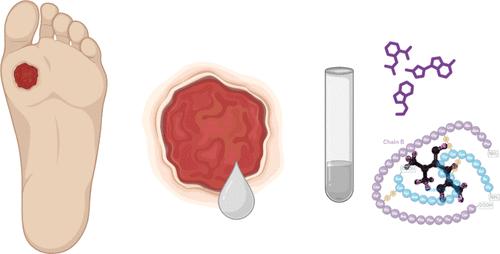Analysis of Biogenic Amines and Small Molecule Metabolites in Human Diabetic Wound Ulcer Exudate
引用次数: 0
Abstract
Diabetic foot ulcers (DFUs) pose a significant challenge in wound care due to their chronic nature and impaired healing processes. This study examines the biogenic amines and small molecule metabolites present in DFU wound exudates to identify their potential roles in wound healing. Under an IRB-approved protocol, wound fluid samples were collected from 25 diabetic patients and analyzed using ultrahigh-pressure liquid chromatography coupled with electrospray ionization quadrupole time-of-flight tandem mass spectrometry. The analysis identified 721 metabolites, with 402 confirmed through stringent criteria. Key metabolites significantly contributing to the wound exudates include betaine, lactic acid, carnitine, choline, creatine, and metformin (a widely used first-line treatment for type 2 diabetes). These molecules are known to influence wound healing processes, such as collagen synthesis, angiogenesis, inflammation modulation, and energy metabolism. Notably, the presence of drugs such as metformin and beclomethasone in the exudates suggests significant pharmacodynamic interactions that could influence wound healing. Specifically, we discovered that the combined use of insulin and metformin administered systemically significantly increased the concentration of metformin in the wound exudates (from 0.3% ± 0.0 to 3.1% ± 3.4; p = 0.00 49). This study highlights the complexity of DFU exudate composition and underscores the potential for targeted metabolic profiling to develop personalized wound care strategies.

人体糖尿病伤口溃疡渗出物中的生物胺和小分子代谢物分析
糖尿病足溃疡(DFU)由于其慢性性质和愈合过程受损,给伤口护理带来了巨大挑战。本研究对 DFU 伤口渗出物中的生物胺和小分子代谢物进行了研究,以确定它们在伤口愈合中的潜在作用。根据 IRB 批准的方案,研究人员收集了 25 名糖尿病患者的伤口渗出液样本,并使用超高压液相色谱法和电喷雾四极杆飞行时间串联质谱法进行了分析。分析确定了 721 种代谢物,其中 402 种经过严格标准确认。对伤口渗出物有重大影响的主要代谢物包括甜菜碱、乳酸、肉碱、胆碱、肌酸和二甲双胍(一种广泛用于治疗 2 型糖尿病的一线药物)。众所周知,这些分子会影响伤口愈合过程,如胶原蛋白合成、血管生成、炎症调节和能量代谢。值得注意的是,渗出液中含有二甲双胍和倍氯米松等药物,这表明药效学相互作用可能会影响伤口愈合。具体来说,我们发现联合使用胰岛素和二甲双胍系统给药会显著增加伤口渗出液中二甲双胍的浓度(从 0.3% ± 0.0 到 3.1% ± 3.4; p = 0.00 49)。这项研究凸显了DFU渗出液成分的复杂性,并强调了有针对性的代谢分析在制定个性化伤口护理策略方面的潜力。
本文章由计算机程序翻译,如有差异,请以英文原文为准。
求助全文
约1分钟内获得全文
求助全文

 求助内容:
求助内容: 应助结果提醒方式:
应助结果提醒方式:


